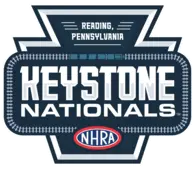

Decal details
I'm still pulling together all of the info from the massive collection of sticker/decal images that you all sent as the result of my two Sticker Shock columns last month, but in the meantime, here are follow-up notes on some of the decals that I showed off.
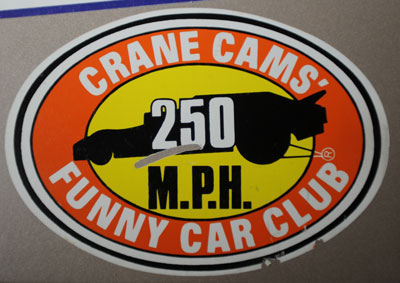 |
After they saw the decal for the Crane Cams 250-mph Club, I heard from Jim Hill and Henry Walther – regular contributors to this column and former employees of Crane Cams – whose memories were stoked by the image of the club logo.
In the announcement, which ran in National DRAGSTER in May 1981, Crane Cams Chairman Harvey J. Crane stated, "Only recently have Top Fuel dragsters begun to run in excess of the 250-mph mark, and we wanted to be the first to recognize what we feel is an accomplishment even greater than running 250 mph in a dragster, doing it in a Funny Car!"
When the club was announced, the NHRA national speed record was 247.25, set by Don Prudhomme a few months earlier in Gainesville (Prudhomme had taken it from a still-not-famous John Force, who ran 246.57 earlier at the event), but the record had stagnated at the 245 mark for more than a year and a half since Gordie Bonin had set the record at 245.90 at the 1979 U.S. Nationals. Robbie Williams was credited with upping the record to 247.95 later that year, but it was an altitude-corrected number recorded at the Denver points meet. Raymond Beadle got tantalizingly close with a 249.30 record at Indy in 1981 before Prudhomme finally did the deed in May 1982 at the Cajun Nationals in Baton Rouge, La.
"The Crane Cams 250-mph Funny Car Club was a project I hatched and was allowed to execute," recalled Hill. "Cragar had established prior clubs, but in spite of their huge popularity, the Funny Car guys seemed to be ignored. Funny Cars were running high 230s and a few 240-mph speeds (remember '240 Gordie' Bonin?), but the 250 seemed to be a barrier for the flopper guys. I thought the 250-mph mark would soon be eclipsed and wanted Crane Cams to be associated with that milestone.
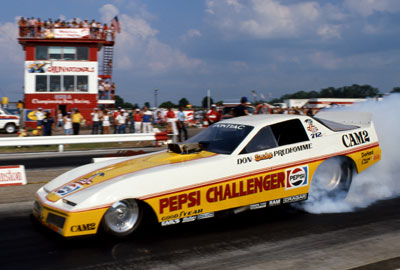
(Above) Don Prudhomme became the first Funny Car driver to eclipse 250 mph in qualifying at the 1982 Cajun Nationals. (Below) From right, Prudhomme, Billy Meyer, and Ken Veney, the club's first members, were congratulated at the 1982 U.S. Nationals by Crane Sales Promotion Manager Jim Hill, second from right.
|
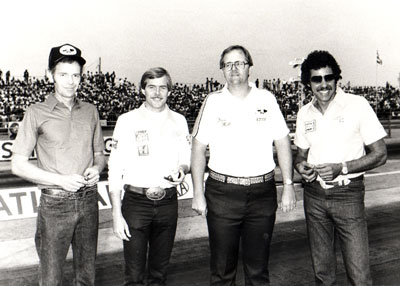 |
"When this program was announced, there was widespread skepticism that a Funny Car could reach a 250-mph speed," said Hill. "As you know, throw a barrier number in a racer's face, and he will find a way to punch through it. That was my mind-set when I proposed the 250 Club to Crane Cams.
"Crane was also just beginning to make serious inroads into the fuel racing market. Up to then, the majority of Top Fuel and Funny Car racers ran flat-tappet camshafts of fairly mild lobe profiles, with a number of problems. Those who tried roller cams saw immediate increases in speeds and e.t.s, plus a reduction or elimination of the fuel-wash, lobe-wiping problems that plagued flat-tappet cams. Engine builders were also beginning to step up to bigger blowers, bigger fuel pumps, ported cylinder heads, and engine combinations ready to respond to more aggressive camshaft profiles. I saw the 250 Club as an opportunity to gain exposure for our steel billet roller cams and roller tappets with nitro engine builders, but the club was also an open membership, regardless of camshaft brand used."
Remembered Walther, "At the time we started that club, I was in charge of running Crane's West Coast operation," he recalled. "As part of my duties, I was responsible for covering most of the NHRA national events with Chase Knight (who is still doing it for Crane today).
"With a fresh supply of decals, patches, and a great illustration of the ring, I set off to the first event to introduce the new club to the Funny Car drivers. What makes this stick out in my mind is the comments of the first driver I approached to announce the club. It was Don Prudhomme. 'Snake' listened to my spiel, looked at the goodies, and then, almost incredulously, proclaimed, 'Yeah, good luck with filling THAT club,' as if it would be years before any Funny Car, much less eight of them, would top the 250-mph mark.
"That somewhat took the wind out of my sails, but, wouldn't you know it, it wasn't long before someone did run 250 in a flopper ... and, of course, it was Prudhomme. Needless to say, it gave me great satisfaction to congratulate him on becoming the first member of the club. I'll have to remind him of that incident the next time we have lunch."
 |
|
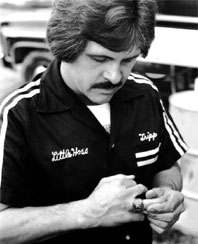
Tripp Shumake was the fourth member of the 250-mph Club and also a member of the Cragar 5-Second Club.
|
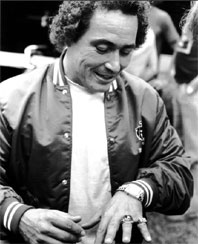
Kenny Bernstein was the 10th driver to record a 250-mph pass, and was made an honorary club member.
|
According to Hill, club members were presented with a solid gold, custom-designed ring created by Jostens, the same company famed for its NFL Super Bowl and MLB World Series rings. The members also received jackets with the driver's name, speed, and the 250-club logo, patches, and logo caps for the crew.
"It was the rings that the guys went gaga over," he remembered. "I would guess that most of the group still have their rings. They cost about $600 each, in 1980s dollars, as gold wasn't quite as pricey as it is today. I would like to think that these rings encouraged them to step up and crack that 250-mph barrier, but, of course, it was the desire to go faster, quicker, and win races that drove them forward.
"The sticker you photographed was one of those I gave to members and media folks in press kits. I saved a few of them, along with a couple of the 250 FC Club patches ... keepsakes from a long time ago. How amazing it is that today a 250-mph run by a Funny Car is a dog, usually a shutoff, early-chutes pass! It was a great promotion that Harvey Crane graciously allowed me to create and generated a lot of positive publicity and interest among all of drag racing. And, of course, it was a bunch of fun for me to produce."
Hill also told me that membership in the eight-driver club was extended on an honorary basis to Al Segrini and Kenny Bernstein, who ran 250.64 and 251.39, respectively, at the 1982 U.S. Nationals after John Force became the eighth and "final" member with a 250.69. Segrini's run was made just after Force's, and Bernstein's came the next day.
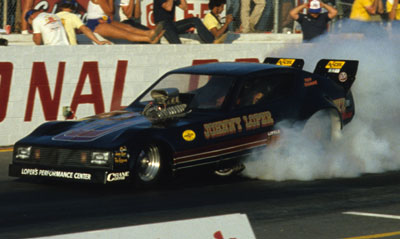 |
"Of the eight drivers who ultimately filled the ranks of the Crane Cams 250-mph Club, none took greater pride in his membership than the late Tripp Shumake," added Walther. "Long after the promotion had run its course, Tripp was still asking me if I had any of the decals or patches available. I always promised I would look for some. A few years later, I was cleaning out a closet and discovered a paper bag filled with the 250-mph decals and patches. I promptly packaged them up and shipped them to Tripp. In retrospect, I am glad I was able to fulfill his request before he left us. Tripp was one of the fun guys you always enjoyed spending time with out on the tour."
I agree with Henry about "Tripper"; he was one of my favorite people, and we lost him way too soon to a motorcycle accident Nov. 13, 1999. Tripp was riding his Harley when he was struck by a hit-and-run driver who was driving on the wrong side of the road near his home in Chandler, Ariz. Atlanta was good to Shumake; he won his first event there, in 1981, and made the club there the following year.
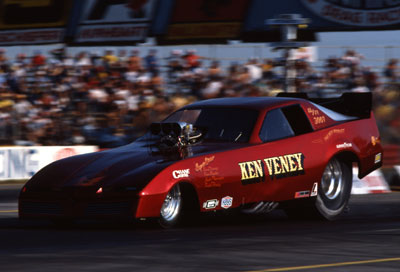 |
For me, though, the most interesting person on the list is the "Wizard of Wadsworth," Ken Veney, who had already had two careers worth of success in the alcohol ranks before he switched to a nitro coupe in 1982; within about a dozen runs, he was a member of the club that so many other more nitro-savvy drivers were not.
"He hit 250 on (I think) his 13th run on nitro," his second-generation driving son, Todd, told me. "It was at the '82 U.S. Nationals, and the conditions were killer. He was going to run cast Dart heads and a flat-tappet cam like everybody else, but he really thought that billet heads with giant intake ports and a roller cam like he had in his alcohol car was the way to go, and I guess it was.
"The whole crew consisted of my dad's friends Jack Phenegar and Tom Ihala, my mom, and me. Jack did the bottom end, and Tom did the clutch. I got to pull the left head the next year, but that first year, I was only allowed to clean the pan. My mom mixed the fuel, and it was 85 percent every time. My all-time hero, Don Prudhomme, and Raymond Beadle, Billy Meyer, Austin Coil, and a bunch of people came by our pit area to check out my dad's new fuel heads, and I hovered in the background, trying to hear what they were talking about. Prudhomme said he might just want to try a set, meaning, if they were free. My dad's exact words: 'I already tried them -- they work.'
"Every run, it kept going quicker -- 5.99, 5.84, 5.78, and 5.73. He beat Raymond Beadle, who had just won the last three championships, in round one and Al Segrini in round two, and it looked like it might just be him and Prudhomme in the final, but they both got beat in the semi's. My dad smoked the tires but did an awesome pedal job for a rookie and almost chased down Gary Burgin, going 252.10 mph to back up his 254.23 for a new national record.
"Like the 17-year-old idiot I was, I traded my Crane 250 Club hat to my friend Tom Schiltz for a picture of one of my dad's old cars. He still has it."

 |
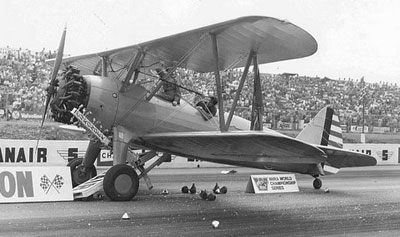 |
The decal for the Sanair track in Canada stoked in reader Thomas Blouin the memory of perhaps the track's second-most infamous "crash" behind Shirley Muldowney's 1984 accident. Blouin was there when a biplane landed on the track as part of the pre-race ceremony at the 1975 event and proceeded to run down the Christmas Tree in a glass- and metal-shattering spray from its propeller. Blouin wrote that the passenger in the plane was the famed Linda Vaughn, but it actually was Miss Molson (name unknown) who rode into infamy.
As is the case with so many of the unbelievable incidents in NHRA's history, former NHRA Competition Director Steve Gibbs had a front-row seat for the event and was happy to share his memories.
"The pilot of the Stearman biplane had made a practice landing at the track earlier in the week, but at the time, none of the starting-line paraphernalia was in place," he remembered. "When he brought the queen in on race day, he taxied right up to the starting line …as he had before, and you can see the results. I once owned a Stearman, and you simply cannot see straight ahead.
"The Christmas Tree instantly became a fragmented mess of metal, glass, and wires. The pilot was pissed, as the prop was badly damaged ... but the queen never quit waving. I was at about the eighth-mile mark, looking on in disbelief. I was sure the guy would stop short of the Tree. We had a spare Tree, but it took some time for Art Hayward to repair the wiring and connector damage. The plane was not flyable, so it had to be towed to the end of the track for future repairs. The last thing I remember was the queen still waving to the crowd."
I mentioned that there were border-crossing horror tales when racers and others headed to Montreal, and former ND Editor Bill Holland had one to share. "I was charged with bringing a few thousand souvenir issues of ND to distribute at the event," he recalled. "It went with me on the plane as 'extra baggage.' Prior to printing the papers, I had contacted the Canadian consulate and asked if we needed to remove the price from the cover, or was it OK to leave it. I was assured that if we were just going to give them away, it would not be necessary. As you can probably guess, the Canadian customs officials had their own ideas.
"So here I sit at the airport with all these bundles, and they want me to pay some exorbitant amount of duty, and I tell them there's no flippin' way. So I start to walk off and tell them something like, 'You can have the papers. I'm not going to pay that kind of money. And besides, I don't have it!' The customs official told me to wait, huddled with cohorts, and came back at me with a figure of around $30 to clear customs. Done! No doubt he didn't want to deal with all those papers. And that's how National DRAGSTER was introduced en masse to the good citizens of Quebec."

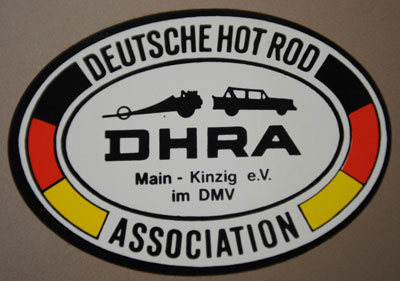 |
I also heard back from Rico Anthes concerning the Deutsche Hot Rod Association decal shown here, and I heard from Jerry "Big Daddy" Lackey regarding the group.
Lackey pointed me to www.dragracinghistory.de, where he said there is plenty of information about how he and a few others "turned a small existing drag racing club into the oldest and largest official drag racing club in most of Europe.
"This was over 41 years ago," he continued, "and I am also the last of the original five grounders still active with the conducting of the best-attended drag race event in Europe, the NitrolympX at the F-1 track in Hockenheim, Germany. We are going into our 26th year at Hockenheim and have had several NHRA drivers here over the years. For our silver anniversary last year, we had Melanie Troxel in her Pro Mod as our NHRA star guest. We have also had a few Top Fuel drivers here from the USA."
According to Anthes, the club was founded and registered May 7, 1979, and was located in Langenselbold, a little town close to Hanau/Erlensee in the Frankfurt area, where at that time all drag racing activities in Germany took place at the U.S. Army airbase, or fliegerhorst. The association's run was relatively short-lived; Anthes found records that DHRA closed all activities Aug. 16, 1990.
OK, that's all for today. Be sure to come back Friday, when I will begin showing off some of your decals.

















